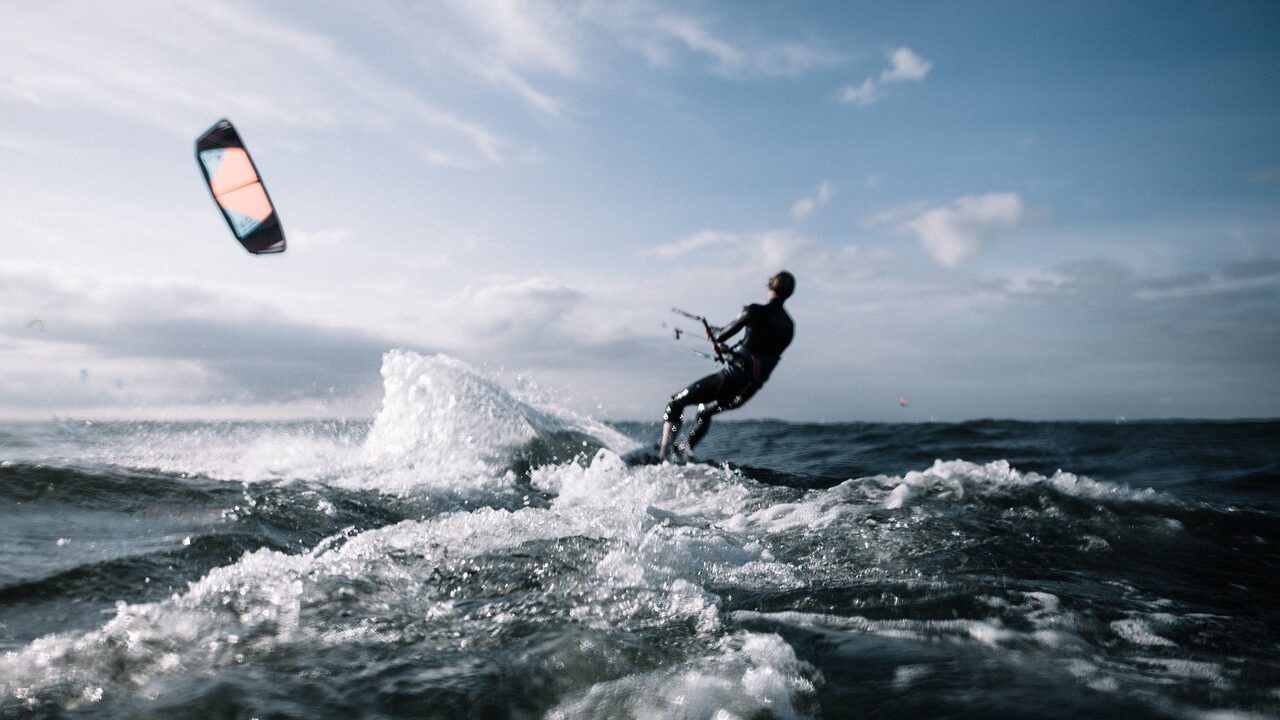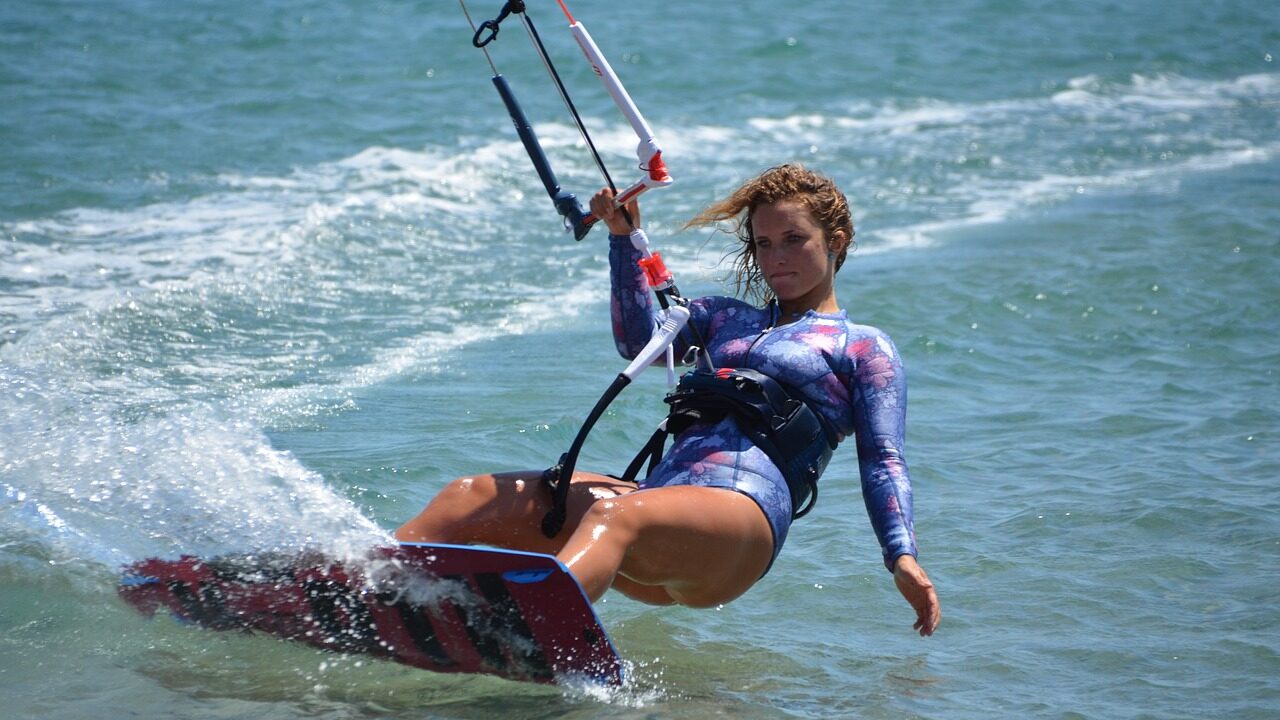
Table of Contents
Imagine the excitement of blending windsurfing, surfing, and wakeboarding into one thrilling water sport – that’s the essence of kitesurfing. Tethered to a kite, riders feel an unparalleled sense of freedom. If you’re venturing into kitesurfing, you’re likely asking, “How long does it take to learn to kitesurf?” Let’s dive into the details and explore the journey of becoming a skilled kitesurfer.
I. Learning To Kitesurf
Embarking on the kitesurfing odyssey reveals a challenging yet rewarding learning curve, with the time required influenced by various factors. The journey typically unfolds through the following stages.
Basics and Safety (1-2 days)
In the initial 1-2 days, beginners dive into the foundational elements of kitesurfing. Critical lessons cover equipment nuances, safety protocols, and understanding concepts like the wind window. This phase lays the groundwork for secure and enjoyable kitesurfing experiences.
Kite Control (1-2 weeks)
Mastering kite control, a pivotal skill, takes around 1-2 weeks of consistent practice. Enthusiasts refine their ability to launch, land, and maneuver the kite with precision, paving the way for progression to advanced kitesurfing proficiency.
Body Dragging (2-4 weeks)
The art of body dragging, essential for retrieving a lost board or navigating back to the shore, requires dedication. Spending 2-4 weeks honing this skill, learners harness the kite’s power, effortlessly gliding through the water, adding practicality and mastery to their kitesurfing repertoire.
Water Start (4-6 weeks)
Transitioning from body dragging, enthusiasts enter the thrilling phase of water starts. On average, individuals invest around 4-6 weeks to become proficient at getting up on the board and harnessing the wind’s energy for a dynamic and exhilarating ride.
Riding Independently (3-6 months)
Reaching the pinnacle of kitesurfing prowess involves conquering challenges like riding independently, maintaining an upwind trajectory, and confidently controlling the kite. This advanced stage demands the most time and practice, typically spanning 3-6 months. However, individual aptitude and practice frequency significantly influence the timeline. It’s during this period that enthusiasts embrace the freedom of gliding over the water, marking the culmination of their dedicated kitesurfing journey.
II. Factors Shaping Your Kitesurfing Journey
Mastering the exhilarating art of kitesurfing is a journey influenced by a multitude of factors, each playing a role in determining how swiftly proficiency is achieved.
Fitness and Conditions
The pace of your kitesurfing progress is significantly affected by your overall fitness level and core strength. Regular engagement in exercises that enhance core strength can expedite your journey through the various learning stages.
Access to suitable wind conditions and well-chosen training locations can impact the speed of your learning journey. Consistent wind and suitable locations create a more conducive learning environment, facilitating easier practice and skill refinement.
Natural Talent vs. Determination
While some individuals may possess a natural inclination for picking up kitesurfing quickly, determination and commitment play substantial roles in the learning process. The willingness to persevere through challenges and maintain consistent practice is key to achieving proficiency.
If you bring prior experience from related board sports like windsurfing or wakeboarding, your adaptation to kitesurfing may be more rapid. Transferable skills from these activities can serve as a solid foundation for quicker mastery.
The age-old saying “practice makes perfect” rings true in kitesurfing. Devoting more time to on-water practice accelerates your progress. Frequent sessions not only build muscle memory but also enhance your comfort and confidence with equipment and techniques.
Kitesurfing Lessons
Enrolling in kitesurfing lessons led by certified instructors can significantly reduce your learning time. Instructors provide structured guidance, teach essential skills, and prioritize safety. Their expertise ensures an efficient and safe navigation of the learning curve.
For beginners, choosing kitesurfing lessons from a certified school is highly recommended. These lessons not only expedite your learning curve but also prioritize safety. A typical beginner’s course spans approximately 12-20 hours of instruction over several days, offering a structured and immersive learning experience that equips you with the skills to confidently navigate the world of kitesurfing.
By comprehending and considering these influencing factors, aspiring kitesurfers can make informed decisions, actively contributing to expediting their journey from novice to proficient rider.

III. Common Timelines in Kitesurfing
Embarking on a kitesurfing adventure is a personal and unique experience, shaped by individual progress influenced by a myriad of factors. While timelines naturally differ, here are some general milestones marking the stages of a typical kitesurfing learning curve.
3-6 Months: Riding Independently and Staying Upwind
Achieving the ability to ride independently, maintain an upwind trajectory, and confidently control the kite typically occurs within the first 3 to 6 months. This period signifies a shift from the initial learning phases to the exhilarating experience of harnessing the wind for a dynamic ride.
6-12 Months: Learning to Jump and Practicing Tricks
As confidence and proficiency grow, the 6 to 12-month mark often witnesses kitesurfers exploring more advanced maneuvers. Learning to jump and experimenting with basic tricks become attainable goals during this phase. The thrill of catching air and incorporating tricks introduces a new dimension to the kitesurfing experience.
12+ Months: Mastering Advanced Moves
Beyond the first year, kitesurfers may delve into the realm of more advanced moves. Mastering techniques such as kite loops, handle passes, and freestyle tricks becomes a focus for those aiming to elevate their skills. This stage is marked by a deeper understanding of the sport’s nuances and an elevated level of control and finesse.
It’s important to recognize that these timelines are generalizations, and individual progress can vary based on factors such as dedication, practice frequency, and natural aptitude. Moreover, the kitesurfing learning journey doesn’t have a strict endpoint; rather, it evolves into a continuous exploration of new challenges and mastery.
Embracing the Unique Learning Journey
Above all, the essence of the kitesurfing journey lies in the enjoyment of the learning process and the thrill of the sport. Every individual’s path is distinct, shaped by their unique circumstances and commitment. Instead of fixating on specific timelines, kitesurfers should embrace the ongoing adventure, relishing each new skill acquired and savoring the excitement of being propelled across the water by the power of the wind. After all, the beauty of kitesurfing lies not just in the destination but in the exhilarating journey itself.
IV. Accelerate Learning in Kitesurfing
Quickening your progress in kitesurfing involves a holistic approach, blending physical fitness, mental preparation, determination, and a realistic mindset. Here are some valuable tips to expedite your learning journey.
Consistent Practice
Consistency is paramount in kitesurfing. The more time spent on the water, the quicker the progress. Regular practice not only builds muscle memory but also enhances understanding of wind, water conditions, and kite control. Aim for frequent, focused practice to reinforce skills and develop confidence in various aspects of the sport.
Approach kitesurfing with a determined mindset and a willingness to learn from mistakes. Embrace challenges as opportunities for growth rather than setbacks. Every fall, misstep, or struggle is a valuable lesson contributing to your overall improvement. With determination, setbacks transform into stepping stones toward mastering the sport.
Regular exercise, particularly core strength training, is pivotal for success in kitesurfing. A robust core improves your balance, stability, and overall control while riding the board. Integrate exercises targeting core muscles to build strength and endurance, laying a solid foundation for mastering kitesurfing maneuvers.
Setting Realistic Expectations
While the journey to proficiency in kitesurfing is immensely rewarding, setting realistic expectations is crucial. Acknowledge that challenges and frustrations are inherent in the learning process. Be patient and understand that progress may come in increments. Perseverance and a positive mindset will guide you through obstacles, allowing you to embrace the learning curve with enthusiasm and resilience.
Leverage the potency of visualization to enhance your kitesurfing performance. Before hitting the water, invest time in mentally rehearsing key techniques and maneuvers. Visualization creates a mental map of the actions you’ll take, reinforcing muscle memory and boosting confidence during real-time execution.
By incorporating these tips into your kitesurfing journey, you can accelerate your learning curve and derive greater enjoyment from the process. Kitesurfing is not only a physical challenge but also a mental and personal one. Fostering a holistic approach to your development will see you riding the waves with increasing skill and confidence.
V. Conclusion
Embarking on the exhilarating journey of kitesurfing is a personal odyssey, a narrative woven with challenges, triumphs, and the sheer joy of conquering the waves. Throughout this extensive exploration, we’ve navigated the intricate stages of the kitesurfing learning curve, from mastering the basics to soaring into advanced maneuvers.
How Long Does It Take To Learn To Kitesurf
Recognizing that the timeline for mastering kitesurfing is as diverse as the individuals embracing the sport, we’ve delved into the influencing factors shaping each rider’s unique trajectory. Fitness, prior experience, determination, consistent practice, professional instruction, and favorable weather conditions interweave to accelerate the learning process.
Venturing into common timelines provides aspiring kitesurfers with a roadmap for their own progression, from the initial thrill of riding independently to the mastery of advanced tricks. Yet, it’s crucial to acknowledge that these benchmarks are flexible, influenced by personal commitment and the sheer enjoyment of the journey.
Kitesurfing lessons emerge as a recommended accelerator, offering structured guidance and safety prioritization. The shared experiences within a certified school’s 12-20 hour beginner’s course create a foundation propelling learners toward confident navigation of the kitesurfing realm.
As we emphasize the importance of embracing the unique learning journey, we recognize that the allure of kitesurfing lies not solely in reaching milestones but in savoring the ongoing adventure. The provided tips, from staying fit to visualizing success and maintaining determination, serve as beacons for those eager to expedite their progression.
In the end, setting realistic expectations becomes the cornerstone of a fulfilling kitesurfing experience. Challenges and setbacks are not obstacles but integral components of the learning process. With patience, perseverance, and a positive mindset, every fall becomes a step towards mastery.
Explore the exhilarating world of kitesurfing as we unravel the question, ‘Is Kitesurfing Dangerous?’ in our insightful article. Delve into the risks and rewards of this dynamic water sport, where we navigate through safety measures and expert insights to provide a comprehensive perspective for enthusiasts and potential riders alike.

